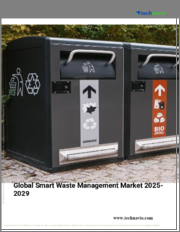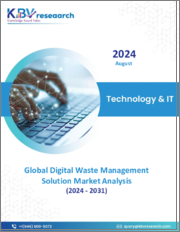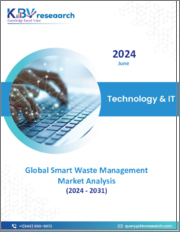
|
시장보고서
상품코드
1521126
세계의 스마트 폐기물 관리 시장 보고서 : 컴포넌트, 폐기물 유형, 방법, 배출원, 지역별(2024-2032년)Smart Waste Management Market Report by Component, Waste Type, Method, Source, and Region 2024-2032 |
||||||
세계의 스마트 폐기물 관리 시장 규모는 2023년 26억 달러에 달했습니다. 향후 IMARC 그룹은 시장이 2032년까지 77억 달러에 이를 전망이며, 2024년과 2032년 사이에 12.5%의 복합 연간 성장률(CAGR)을 나타낼 것으로 예측했습니다.
스마트 폐기물 관리는 사물 인터넷(IoT) 지원 스마트 폐기물 센서를 활용하여 폐기물 수집을 최적화하고 넘치는 휴지통 수를 줄이고 도시 자원을 관리합니다. 기존 네트워크를 활용하기 위해 전력 효율이 우수한 셀룰러 네트워크 기술에 의존하고 있습니다. 스마트 시티 에코시스템에는 필수적이며 쓰레기 수거 프로세스의 운영 비효율로 인한 불필요한 비용을 절감합니다. 위치, 온도 및 충전 레벨을 실시간으로 감지하고 연료와 인력을 절약하는 최적의 수집 경로를 계획하는 데 도움이 됩니다. 그 결과, 세계의 주택, 상업, 공업 부문에서 응용되고 있습니다.
스마트 폐기물 관리 시장 동향 :
폐기물 수집, 처리 및 관리의 어려움이 증가함에 따라 스마트 시티의 발전이 시장을 견인하는 주요 요인 중 하나가되었습니다. 또한 지능형 모니터링, 경로 최적화, 분석 등 스마트 폐기물 관리의 이점에 대한 개인 의식이 높아짐에 따라 시장 성장이 촉진되고 있습니다. 게다가 세계에서 센서 기술의 사용이 증가하고 있습니다. 이는 지속가능한 폐기물 처리를 위한 여러 국가의 정부와 지방자치단체의 이니셔티브 증가와 함께 시장에 긍정적인 영향을 미칩니다. 이 외에도 스마트 폐기물 관리는 유리, 오염된 바늘, 의료 폐기물로 부상을 입는 등 쓰레기 수거 중 사고를 줄이는 데 도움이 되기 때문에 수요가 세계의적으로 증가하고 있습니다. 이에 따라 엄격한 규제기관은 노동자 안전에 대한 조직의 관심을 높여 업계 투자자들에게 유리한 성장 기회를 제공합니다. 기타 성장 요인으로는 급속한 산업화 및 도시화, 폐기물의 효율적인 재활용 및 재처리 요구 증가가 포함됩니다.
목차
제1장 서문
제2장 조사 범위와 조사 방법
- 조사의 목적
- 이해관계자
- 데이터 소스
- 1차 정보
- 2차 정보
- 시장 추정
- 상향식 접근
- 하향식 접근
- 조사 방법
제3장 주요 요약
제4장 소개
- 개요
- 주요 업계 동향
제5장 세계의 스마트 폐기물 관리 시장
- 시장 개요
- 시장 실적
- COVID-19의 영향
- 시장 예측
제6장 시장 분석 : 컴포넌트별
- 솔루션
- 시장 동향
- 주요 부문
- 플릿 관리
- 원격 모니터링
- 데이터 분석 및 고급 보고서
- 네트워크 관리
- 자산운용관리
- 시장 예측
- 서비스
- 시장 동향
- 주요 부문
- 전문 서비스
- 매니지드 서비스
- 시장 예측
제7장 시장 분석 : 폐기물 유형별
- 고체
- 시장 동향
- 시장 예측
- 특수
- 시장 동향
- 시장 예측
- 전자폐기물
- 시장 동향
- 시장 예측
제8장 시장 분석 : 방법별
- 스마트 수집
- 시장 동향
- 시장 예측
- 스마트 처리
- 시장 동향
- 시장 예측
- 스마트 폐기
- 시장 동향
- 시장 예측
- 스마트 에너지 회수
- 시장 동향
- 시장 예측
제9장 시장 분석 : 배출원별
- 주택
- 시장 동향
- 시장 예측
- 상업
- 시장 동향
- 시장 예측
- 산업
- 시장 동향
- 시장 예측
제10장 시장 내역: 지역별
- 북미
- 미국
- 캐나다
- 아시아태평양
- 중국
- 일본
- 인도
- 한국
- 호주
- 인도네시아
- 기타
- 유럽
- 독일
- 프랑스
- 영국
- 이탈리아
- 스페인
- 러시아
- 기타
- 라틴아메리카
- 브라질
- 멕시코
- 기타
- 중동 및 아프리카
- 시장 동향
- 시장 분석 : 국가별
- 시장 예측
제11장 SWOT 분석
- 개요
- 강점
- 약점
- 기회
- 위협
제12장 밸류체인 분석
제13장 Porter's Five Forces 분석
- 개요
- 구매자의 협상력
- 공급기업의 협상력
- 경쟁도
- 신규 참가업체의 위협
- 대체품의 위협
제14장 가격 분석
제15장 경쟁 구도
- 시장 구조
- 주요 기업
- 주요 기업 프로파일
- Bigbelly Inc.
- Bin-e
- Ecube Labs Co. Ltd.
- Enevo(REEN AS)
- Evreka
- GreenQ Ltd.
- Pepperl Fuchs SE
- RecycleSmart Solutions
- Rubicon Technologies LLC
- Sensoneo
- Suez SA
- Veolia Environnement SA
The global smart waste management market size reached US$ 2.6 Billion in 2023. Looking forward, IMARC Group expects the market to reach US$ 7.7 Billion by 2032, exhibiting a growth rate (CAGR) of 12.5% during 2024-2032.
Smart waste management involves the utilization of internet of things (IoT) enabled smart waste sensors to optimize waste collection, reduce the number of overflowing bins, and manage resources in cities. It relies on cellular network technologies that offer power-efficiency to leverage existing networks. It is an essential part of smart city ecosystem, which reduces unnecessary expenses due to operational inefficiencies in trash collection processes. It helps detect location, temperature, and fill level in real time to plan optimal collection routes that save fuel and manpower. As a result, it finds applications in the residential, commercial, and industrial sectors around the world.
Smart Waste Management Market Trends:
A rise in the development of smart cities, along with the growing difficulty in waste collection, processing, and management, represents one of the key factors driving the market. Moreover, the increasing awareness among individuals about the benefits of smart waste management, such as intelligent monitoring, route optimization, and analytics, is propelling the growth of the market. In addition, there is an increase in the utilization of sensor technologies across the globe. This, coupled with the growing initiatives by governments and local authorities of several countries towards sustainable waste disposal is positively influencing the market. Besides this, as smart waste management helps reduce accidents while collecting trashes, such as being injured by glass, contaminated needles, and medical wastes, its demand is rising globally. In line with this, the increasing focus of organizations on worker safety on account of stringent regulatory bodies is offering lucrative growth opportunities to industry investors. Other growth-inducing factors are rapid industrialization and urbanization and the rising need for recycling and reprocessing waste efficiently.
Key Market Segmentation:
IMARC Group provides an analysis of the key trends in each sub-segment of the global smart waste management market report, along with forecasts at the global, regional and country level from 2024-2032. Our report has categorized the market based on component, waste type, method and source.
Breakup by Component:
Solution
Fleet Management
Remote Monitoring
Data Analytics and Advanced Reporting
Network Management
Asset Management
Services
Professional Services
Managed Services
Breakup by Waste Type:
Solid
Special
E-Waste
Breakup by Method:
Smart Collection
Smart Processing
Smart Disposal
Smart Energy Recovery
Breakup by Source:
Residential
Commercial
Industrial
Breakup by Region:
North America
United States
Canada
Asia-Pacific
China
Japan
India
South Korea
Australia
Indonesia
Others
Europe
Germany
France
United Kingdom
Italy
Spain
Russia
Others
Latin America
Brazil
Mexico
Others
Middle East and Africa
Competitive Landscape:
The competitive landscape of the industry has also been examined along with the profiles of the key players being Bigbelly Inc., Bin-e, Ecube Labs Co. Ltd., Enevo (REEN AS), Evreka, GreenQ Ltd., Pepperl+Fuchs SE, RecycleSmart Solutions, Rubicon Technologies LLC, Sensoneo, Suez SA and Veolia Environnement S.A.
Key Questions Answered in This Report:
- How has the global smart waste management market performed so far and how will it perform in the coming years?
- What has been the impact of COVID-19 on the global smart waste management market?
- What are the key regional markets?
- What is the breakup of the market based on the component?
- What is the breakup of the market based on the waste type?
- What is the breakup of the market based on the method?
- What is the breakup of the market based on the source?
- What are the various stages in the value chain of the industry?
- What are the key driving factors and challenges in the industry?
- What is the structure of the global smart waste management market and who are the key players?
- What is the degree of competition in the industry?
Table of Contents
1 Preface
2 Scope and Methodology
- 2.1 Objectives of the Study
- 2.2 Stakeholders
- 2.3 Data Sources
- 2.3.1 Primary Sources
- 2.3.2 Secondary Sources
- 2.4 Market Estimation
- 2.4.1 Bottom-Up Approach
- 2.4.2 Top-Down Approach
- 2.5 Forecasting Methodology
3 Executive Summary
4 Introduction
- 4.1 Overview
- 4.2 Key Industry Trends
5 Global Smart Waste Management Market
- 5.1 Market Overview
- 5.2 Market Performance
- 5.3 Impact of COVID-19
- 5.4 Market Forecast
6 Market Breakup by Component
- 6.1 Solution
- 6.1.1 Market Trends
- 6.1.2 Key Segments
- 6.1.2.1 Fleet Management
- 6.1.2.2 Remote Monitoring
- 6.1.2.3 Data Analytics and Advanced Reporting
- 6.1.2.4 Network Management
- 6.1.2.5 Asset Management
- 6.1.3 Market Forecast
- 6.2 Services
- 6.2.1 Market Trends
- 6.2.2 Key Segments
- 6.2.2.1 Professional Services
- 6.2.2.2 Managed Services
- 6.2.3 Market Forecast
7 Market Breakup by Waste Type
- 7.1 Solid
- 7.1.1 Market Trends
- 7.1.2 Market Forecast
- 7.2 Special
- 7.2.1 Market Trends
- 7.2.2 Market Forecast
- 7.3 E-Waste
- 7.3.1 Market Trends
- 7.3.2 Market Forecast
8 Market Breakup by Method
- 8.1 Smart Collection
- 8.1.1 Market Trends
- 8.1.2 Market Forecast
- 8.2 Smart Processing
- 8.2.1 Market Trends
- 8.2.2 Market Forecast
- 8.3 Smart Disposal
- 8.3.1 Market Trends
- 8.3.2 Market Forecast
- 8.4 Smart Energy Recovery
- 8.4.1 Market Trends
- 8.4.2 Market Forecast
9 Market Breakup by Source
- 9.1 Residential
- 9.1.1 Market Trends
- 9.1.2 Market Forecast
- 9.2 Commercial
- 9.2.1 Market Trends
- 9.2.2 Market Forecast
- 9.3 Industrial
- 9.3.1 Market Trends
- 9.3.2 Market Forecast
10 Market Breakup by Region
- 10.1 North America
- 10.1.1 United States
- 10.1.1.1 Market Trends
- 10.1.1.2 Market Forecast
- 10.1.2 Canada
- 10.1.2.1 Market Trends
- 10.1.2.2 Market Forecast
- 10.1.1 United States
- 10.2 Asia-Pacific
- 10.2.1 China
- 10.2.1.1 Market Trends
- 10.2.1.2 Market Forecast
- 10.2.2 Japan
- 10.2.2.1 Market Trends
- 10.2.2.2 Market Forecast
- 10.2.3 India
- 10.2.3.1 Market Trends
- 10.2.3.2 Market Forecast
- 10.2.4 South Korea
- 10.2.4.1 Market Trends
- 10.2.4.2 Market Forecast
- 10.2.5 Australia
- 10.2.5.1 Market Trends
- 10.2.5.2 Market Forecast
- 10.2.6 Indonesia
- 10.2.6.1 Market Trends
- 10.2.6.2 Market Forecast
- 10.2.7 Others
- 10.2.7.1 Market Trends
- 10.2.7.2 Market Forecast
- 10.2.1 China
- 10.3 Europe
- 10.3.1 Germany
- 10.3.1.1 Market Trends
- 10.3.1.2 Market Forecast
- 10.3.2 France
- 10.3.2.1 Market Trends
- 10.3.2.2 Market Forecast
- 10.3.3 United Kingdom
- 10.3.3.1 Market Trends
- 10.3.3.2 Market Forecast
- 10.3.4 Italy
- 10.3.4.1 Market Trends
- 10.3.4.2 Market Forecast
- 10.3.5 Spain
- 10.3.5.1 Market Trends
- 10.3.5.2 Market Forecast
- 10.3.6 Russia
- 10.3.6.1 Market Trends
- 10.3.6.2 Market Forecast
- 10.3.7 Others
- 10.3.7.1 Market Trends
- 10.3.7.2 Market Forecast
- 10.3.1 Germany
- 10.4 Latin America
- 10.4.1 Brazil
- 10.4.1.1 Market Trends
- 10.4.1.2 Market Forecast
- 10.4.2 Mexico
- 10.4.2.1 Market Trends
- 10.4.2.2 Market Forecast
- 10.4.3 Others
- 10.4.3.1 Market Trends
- 10.4.3.2 Market Forecast
- 10.4.1 Brazil
- 10.5 Middle East and Africa
- 10.5.1 Market Trends
- 10.5.2 Market Breakup by Country
- 10.5.3 Market Forecast
11 SWOT Analysis
- 11.1 Overview
- 11.2 Strengths
- 11.3 Weaknesses
- 11.4 Opportunities
- 11.5 Threats
12 Value Chain Analysis
13 Porters Five Forces Analysis
- 13.1 Overview
- 13.2 Bargaining Power of Buyers
- 13.3 Bargaining Power of Suppliers
- 13.4 Degree of Competition
- 13.5 Threat of New Entrants
- 13.6 Threat of Substitutes
14 Price Analysis
15 Competitive Landscape
- 15.1 Market Structure
- 15.2 Key Players
- 15.3 Profiles of Key Players
- 15.3.1 Bigbelly Inc.
- 15.3.1.1 Company Overview
- 15.3.1.2 Product Portfolio
- 15.3.2 Bin-e
- 15.3.2.1 Company Overview
- 15.3.2.2 Product Portfolio
- 15.3.3 Ecube Labs Co. Ltd.
- 15.3.3.1 Company Overview
- 15.3.3.2 Product Portfolio
- 15.3.4 Enevo (REEN AS)
- 15.3.4.1 Company Overview
- 15.3.4.2 Product Portfolio
- 15.3.5 Evreka
- 15.3.5.1 Company Overview
- 15.3.5.2 Product Portfolio
- 15.3.6 GreenQ Ltd.
- 15.3.6.1 Company Overview
- 15.3.6.2 Product Portfolio
- 15.3.7 Pepperl+Fuchs SE
- 15.3.7.1 Company Overview
- 15.3.7.2 Product Portfolio
- 15.3.8 RecycleSmart Solutions
- 15.3.8.1 Company Overview
- 15.3.8.2 Product Portfolio
- 15.3.9 Rubicon Technologies LLC
- 15.3.9.1 Company Overview
- 15.3.9.2 Product Portfolio
- 15.3.10 Sensoneo
- 15.3.10.1 Company Overview
- 15.3.10.2 Product Portfolio
- 15.3.11 Suez SA
- 15.3.11.1 Company Overview
- 15.3.11.2 Product Portfolio
- 15.3.12 Veolia Environnement S.A.
- 15.3.12.1 Company Overview
- 15.3.12.2 Product Portfolio
- 15.3.12.3 Financials
- 15.3.12.4 SWOT Analysis
- 15.3.1 Bigbelly Inc.



















